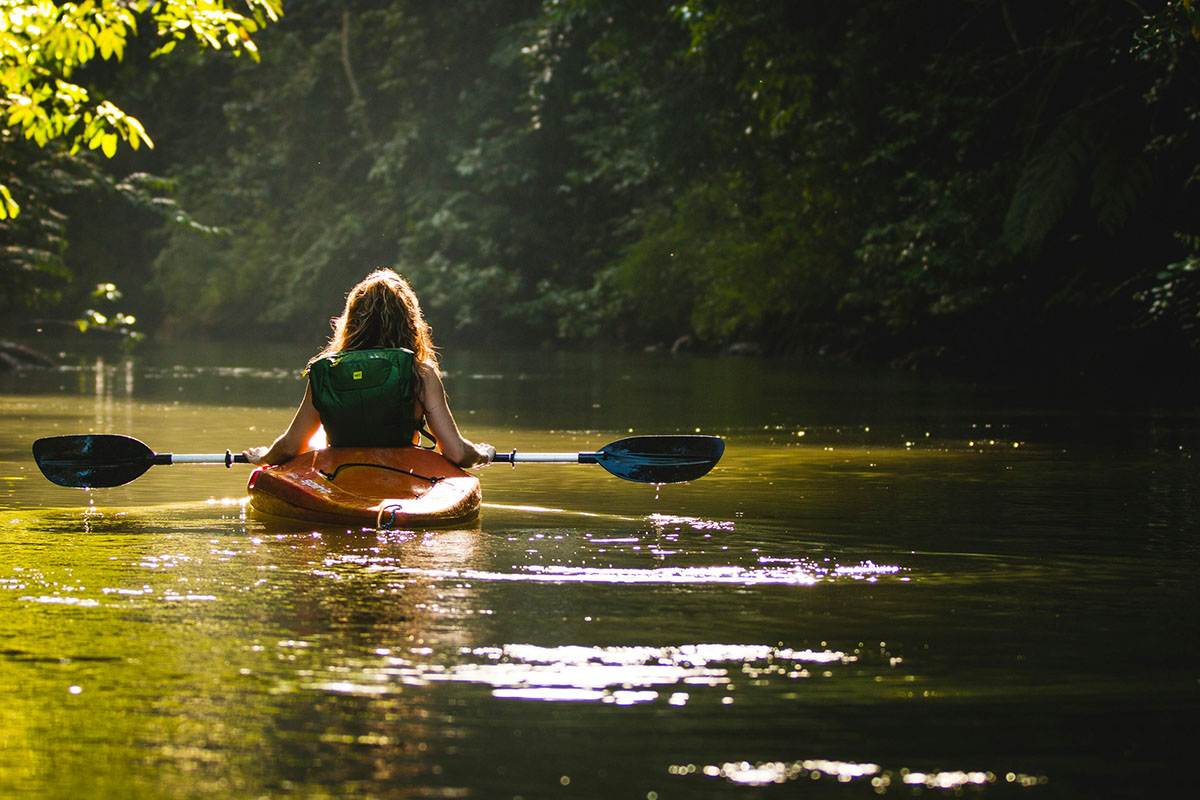

Summer is approaching, and that means it’s time to get back on the water, but if you’ve always spent summers standing on the shore, it might be time to get yourself on that gorgeous blue water with a new kayak. If you’re new to kayaking, we’ve got all the info you need to get the best kayak for you.
Videos by Outdoors with Bear Grylls
Beginners may not want all the bells and whistles of advanced boats. You don’t want to find yourself spilling out of the kayak or struggling to get back on after going for a swim. You just want to have a good time on the water with something that is easy to use.
The best kayak for beginners is the Wilderness Systems Tarpon 105. It is made with high-quality attention to detail and features that allow you to use it in different types of water, has great storage, and is comfortable to use.
We’ve also got picks for the best sit-on kayak, the best inflatable kayak, the best tandem kayak, and the best kayak if you want to save some cash. Don’t forget to check out the kayak buying guide.
This post contains affiliate links. Outdoors.com may earn a commission when you make a purchase through these links. Thank you for your support.
Our Top Picks: Best Kayaks for Beginners
- Best Overall Beginner Kayak for Beginners: Wilderness Systems Tarpon 105
- Best Sit-On Kayak for Beginners: Perception Hi Life 11.0 Sit-On-Top Kayak
- Best Inflatable Kayak for Beginners: Kokopelli Platte Inflatable Kayak
- Best Tandem Kayak for Beginners: Perception Rambler 13.5
- Best Budget Kayak for Beginners: Pelican Argo 100X EXO Kayak
Best Overall Beginner Kayak: Wilderness Systems Tarpon 105

Specs:
- Length: 10 feet 6 inches
- Width: 32 inches
- Weight: 55 pounds
- Weight capacity: 325 pounds
The Tarpon 105 touring kayak from Wilderness Systems is a popular choice as a recreational touring kayak for athletes of any level, especially beginners. For someone who wants to get into paddling and wants to start with a kayak they can have for years, go with the Tarpon touring kayak.
A revitalized version of the initial Tarpon kayaks, this model is really easy to get in and out of, as it’s a sit-on-top kayak. It has a simple seat and foot brace adjustment. By adjusting the foot braces, paddlers can optimize their leg positioning for better comfort and control while paddling. If your feet are properly supported and aligned, you’ll get less tired throughout the day and be able to paddle more easily.
It has SlideTrax accessory rails that let you customize your kayak for fishing, filming, or other activities. It has a broad stern, so it’s incredibly stable—a necessity for beginner kayaks.
We love how the dog-friendly deck allows you to pack not just your gear but also your furry friend. It can be taken out in flat water and saltwater.
The seat is elevated, so you have better visibility, and it tends to be more comfortable, rather than straining to see.
The Tarpon 105 is compatible with fishing poles and fishing rod holders, GPS units, and fishfinder screens and can navigate easily through narrow inlets and sharp curves. The Targon is shorter than many sit-on-top kayaks, so that makes it easier to control and manipulate.
There are a ton of spots to stuff your gear, including a quick-park paddle holder, which is fantastically convenient. Handling paddles can be difficult for beginners, so that makes things a lot easier. There’s dry storage in the front hatch, a mesh cover over the rear storage, and more sectioned storage with a tray to organize little items like your sunscreen, phone, or keys. Plus, there’s a larger rear storage space that can fit a crate, cooler, or other equipment like scuba tanks, if you’re a dual-sport kayaker.
The only trade-off is the weight. Carrying a 55-pound boat is a hefty undertaking. It does have rigid carry handles, so at least you know they are made for the weight.
Why We Love It
- Sturdy
- Lots of storage space
- Can handle tight turns
What Could Be Improved
- Not very fast
- Heavy
Best Sit-On Kayak: Perception Hi Life 11.0 Sit-On-Top Kayak
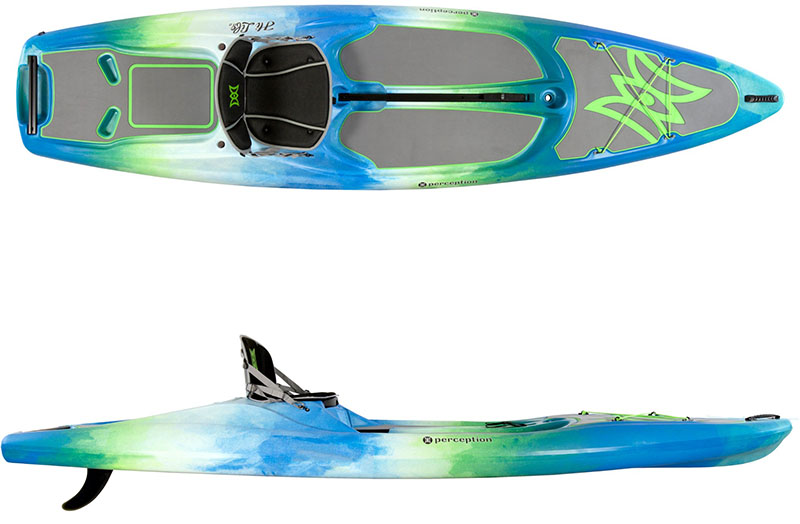
Specs:
- Length: 11 feet
- Width: 34 inches
- Weight: 55 pounds
- Weight capacity: 280 pounds
When you think of fun on the water, you’re going to think of the Perception Hi Life. This kayak for beginners is a great go-to for days on the water or lake when you just want to enjoy yourself, do some swimming, maybe some paddleboarding, and possibly want to bring along the kids.
One of the great features of this kayak is the low-profile swimming deck in the back, so you (or your friends) can get on and off easily. It’s a great place to also have your dog balancing while you both paddle away.
The elevated seat is supportive and comfortable; it has a back rest that you can fold down or leave up, and it has lots of padding, so it’s comfortable for those not used to a kayak seat. There’s a super convenient cooler underneath your seat, so you can have snacks and drinks on hand in just a few moments. There’s a cushioned grippy surface to keep your feet from sliding and even a drink holder.
The best part is the convertibility to a stand-up paddleboard. It has a super low profile as a boat, so you can stand up and paddle it along. It’s going to have a bit less stability because of the design, but once you get used to the paddleboarding technique, you’ll be fine.
A center rail runs from bow to seat and acts as a slide track to mount accessories, and there are carry handles for when you need to move the boat around on land.
Why We Love It
- Can be used as a kayak and a paddleboard
- Built-in cooler
- Swim decks for easy entry and exit
What Could Be Improved
- Less stable hull
- Expensive
Best Inflatable Kayak: Kokopelli Platte Inflatable Kayak

Specs:
- Length: 10 feet 3 inches
- Width: 34 inches
- Weight: 37.5 pounds
- Weight capacity: 330 pounds
Surprisingly tough for an inflatable kayak, the Kokopelli Platte is a fantastically small and useful inflatable kayak for beginners who want a good kayak for recreational paddling on calm lakes and open waters. This kayak also works for the experienced paddler and ensures smooth sailing along lakes and smooth waters. Inflatable kayaks are great if you want to pack up your kayak and travel to a lot of different places without needing a car rack.
An update to previous Moki inflatable kayaks, the Platte has better tracking, is more durable, and is more firm than previous models. Made from 1,000 denier PVC, it’s one of the most durable inflatable folding kayaks, so you don’t have to get stressed every time you brush a rough wall or beach.
Compared to many inflatable kayaks, it has extra features, like two removable fins to help with tracking and keeping in a straight line. The drop-stitch floor keeps it stiff after inflation up to 2 PSI. The hardest part of owning an inflatable kayak is to keep it firm, and the Platte performs well.
There is not a lot of storage here, but with the use of dry bags, you can keep your valuables, clothes, and snacks dry.
For a great day of bay or river kayak paddling where you don’t want to lug around a huge boat, this inflatable folding kayak is a great choice.
Why We Love It
- Easy to carry
- Packs down small
- Self-bailing floor
What Could Be Improved
- Less storage space compared to a folding kayak
Best Tandem Kayak: Perception Rambler 13.5

Specs:
- Length: 13 feet 6 inches
- Width: 34 inches
- Weight: 78 pounds
- Weight capacity: 550 pounds
The Rambler times two, this two-person kayak is best for calm lakes, ponds, and calm coastal waters. This sit-on-top kayak has great stability and works well to overcome the bumpy waters of ocean bays or slow-moving rivers. The best part—you can bring a friend.
There’s a generous tankwell and recessed storage that is reachable, so you can grab anything you need easily. It may be tandem, but you can still paddle alone, so it’s versatile, but just bear in mind it’s quite heavy, so you may need help to move it to the water.
Great for any level of kayaker, the kayak’s rigid, hard shell and molded-in footwells make it great for maneuvering—and it’s comfortable while doing so.
This tandem sea kayak is really versatile, so you can take it to many different locations. Tandem kayaks in general are great for beginners because you can take a more experienced kayaker with you or just share the load of learning together.
There’s an exposed rear storage area for your extra stuff (stored in a dry bag, preferably), super comfortable seats with padding that can be removed, and a backrest with adjustable lumbar support, and there’s a kid or dog seat in the middle and molded-in handles with lockable security.
Some users note minor drawbacks such as tracking issues in rough waters and its relatively heavy weight, but reviews focus on how great it is as a recreational tandem kayak.
Why We Love It
- Comfortable padding and lumbar support
- Option to paddle alone
- Dog or child seat
- Good storage
What Could Be Improved
- Pretty heavy
- May not be great in rough waters
- Molded-in footwells may be uncomfortable for some paddlers
Best Budget Kayak for Beginners: Pelican Argo 100X EXO Kayak
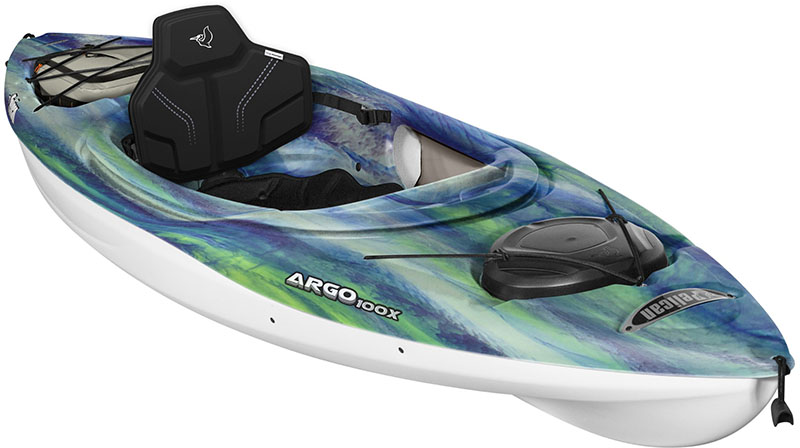
Specs:
- Length: 10 feet
- Width: 28 inches
- Weight: 36 pounds
- Weight capacity: 275 pounds
This kayak takes the cake as a great light and affordable kayak for beginners. Many beginner kayakers may not want to invest nearly a thousand dollars in a kayak when they are just getting into the sport. That’s why it’s nice to invest in something easy to use that is a great price.
This popular kayak for beginners is a sit-in kayak, so that means it will be slightly more comfortable and work well for long paddling sessions.
It only weighs 36 pounds, so you carry it by yourself. Despite its smaller size of 10 feet, there is still storage in the ExoChill 17-liter box, where you can strap it in. The ExoChill is waterproof and will keep your stuff dry. There is more storage, too—a waterproof front storage hatch and a rear tank well with bungees and a bottle holder.
This comfortable sit-in kayak has an adjustable Ergolounge padded backrest with seat cushion and molded footrests. The Ergolounge seating system wraps around your body for extra comfort and support. It’s so comfortable you won’t want to get out.
For a small kayak, it has really hard-wearing Ram-X impact-resistant material, so it will last you a long time, even though it’s less expensive than other kayaks on this list. It’s a great choice for beginners.
Why We Love It
- Super affordable
- Durable
- Great storage
What Could Be Improved
- May be less stable
- Less customizable seating
Buyer’s Guide: How to Choose a Kayak
Do you want to leisurely paddle on calm waters, or do you seek the thrill of whitewater adventures or calm coastal exploration? Understanding what you’re going to do with your new kayak will help you narrow down your options. In this kayak buying guide, we’ll go over everything you need to know.
First, single kayaks refer to kayaks designed to accommodate only one person. If you want to paddle with friends, look at tandem kayaks. That’s your first decision. Here are some more considerations.
Sit on Top vs. Sit Inside
The biggest choice for beginners is whether to get a sit-on-top or a sit-inside kayak. Sit-on-top kayaks offer easy entry and exit, making them great for beginners and warm-weather paddling. Sit-inside kayaks provide better protection from the elements and are better for cooler climates and rough water. They can also be more comfortable with more back support. Sit-in kayaks may feel claustrophobic, but they are more secure and tend to be lighter.
Simply put, a sit-on-top kayak is a floating deck (which is why some double as paddleboards). Sit-on-top kayaks are better if you want to get in and out of the water or if you want to fish. Sit-in kayaks have you put your legs down into the cavity of the kayak.
Size and Weight
Longer kayaks generally offer better tracking and speed, making them better for longer trips and open waters, while shorter kayaks are easier to control and better suited for tight waterways and chill paddling. Wherever you go, you will need to carry your boat. A lighter kayak is easy to carry and are the best beginner kayaks.
You’ll want to check the weight of the kayak to make sure you can carry it, unless you plan to always kayak with a friend. Check out what kind of handles the kayak has and make sure they are sturdy enough that you will be able to carry it alone, if you need to.
If you choose a heavier kayak, you can get a kayak cart to help you transport your kayak over land. It typically consists of a frame with wheels and straps to hold the kayak in place. Kayak carts are used to move kayaks from a vehicle to the water’s edge or vice versa, making it easier to transport the kayak on sand, gravel, or pavement.
Comfort
Check out the back support on the kayak you’re considering. Is there foam padding or adjustable back support? Lumbar support or padding for the seat? Checking out the seat features will allow you to find one that makes sense for what you plan to do: stay out all day, lounge in the sun, or paddle till dusk. See if the kayak has foot braces that are the right length for you, thigh pads, and an ergonomic cockpit design.
Thigh and knee padding offers extra cushioning to protect the paddler’s thighs and knees. This padding helps to prevent bruising during long paddling sessions and allows you to brace your knees against the sides of the kayak, which can help with control.
You may want extra features like a spray skirt—a covering for the opening of the cockpit, sealing the kayaker inside and preventing water from entering the boat to keep you dry.
Safety
You may want to carry a whistle just in case, or look for a boat with a mount for a visibility flag or a place to hang a light.
Storage Space
Most kayaks have storage. Check whether it’s waterproof or exposed. A lot of kayaks have exposed bungee storage that requires a dry bag if you want to keep your stuff dry. Fancy kayaks may even have coolers for your food, cup holders, pockets for your keys and sunscreen, or just larger storage areas for gear, like stuff for fishing or scuba diving.
Paddles
It is a good idea to visit a local store and get sized for your kayak paddles or refer to a size chart based on your height and boat width. Standard recreational kayak paddle blades are made of fiberglass with a nylon plastic blade and are generally considered a good start for beginners using recreational kayaks.
Frequently Asked Questions
What type of kayak is better for beginners?
For beginners, sit-on-top kayaks are generally recommended, because they’re obvious to use and often have features to make them easy to get in and out of. They also tend to have greater stability compared to sit-inside kayaks and have wider hulls. The open cockpit design of a sit-on-top kayak provides beginners with a sense of freedom and will keep you from feeling confined.
Kayaks to consider include whitewater kayaks, if that’s your choice activity, or a river kayak, a fishing kayak, a pedal kayak, or a folding kayak, if you need to pack it into a small place.
What are the three golden rules of recreational kayaking?
The three golden rules of recreational kayaking are:
- Wear a personal flotation device while on the water, in case you capsize.
- Be aware of your surroundings and look for potential hazards such as strong currents, obstacles, and changing weather.
- Learn paddling techniques, including how to hold the paddle and stroke correctly, and have good posture.
Is a sit-on or sit-in kayak better for beginners?
For beginners, a sit-on-top kayak is often considered better than a sit-inside kayak. Sit-on-top kayaks are generally more stable and easier to maneuver, making them better for those new to the sport, and they are easier to get in and out of, which can be reassuring for beginners who may feel uncomfortable or claustrophobic in an enclosed cockpit. They are less likely to fill with water if capsized, making them safer for beginners still learning correct paddling techniques.
How long should a beginner kayak be?
For beginners and casual paddling, a kayak length of around 10 to 12 feet is generally recommended. Kayaks in this size range are more stable, easy to maneuver, and track well. Since they’re easier to control, they’re better for learning basic paddling techniques. Shorter and lighter kayaks are easier to transport, which can be advantageous for those needing to load and unload their kayak frequently.
Do kayaks flip over easily?
Kayaks are generally safe to use and do not tip over unless you’re in rough water or if you hit an obstacle. Calm lakes are a great place to start. Find a recreational kayak for beginners that has a stable hull.
What are the common mistakes beginners make while kayaking?
Beginner kayakers may make common mistakes like launching in dangerous water, using busy waterways with lots of obstacles and traffic, going out in weather that is not ideal, and being overconfident and trying waters that are too hard.
Paddling amongst boat traffic requires extra care due to wind resistance caused by larger boat’s wakes.
The Best Kayaks for Beginners for 2024
Getting your first kayak is exciting, but it may also be overwhelming. Checking what local water systems you will be kayaking in is a great place to start when you want to narrow down options.
Taking the time to research different kayaks and find the right fit will help you have a better time and feel more comfortable as you get used to the water.
You’ll want to make sure you get a boat that is comfortable, has features you like—like a loading deck—and has the right amount of storage for how many drinks (or dogs) you like to bring along.
Our top pick for the best all-around beginner kayak is the Wilderness Systems Tarpon 105. This adventure and fishing kayak has thoughtful features, tons of storage, isn’t too big or heavy, and is easy to use for beginners.
Whether you are heading out to explore a few rivers, want to venture into coastal waters, or just hang out and swim on the lake, we hope you now have the tools to find the right kayak to help you have an epic summer.







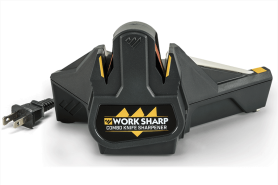
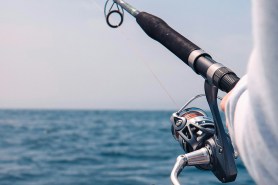

Pingback: 5 Best Kayaks for Beginners in 2024 – Top Market News
Pingback: 5 Best Kayaks for Beginners in 2024 – Market Journalist